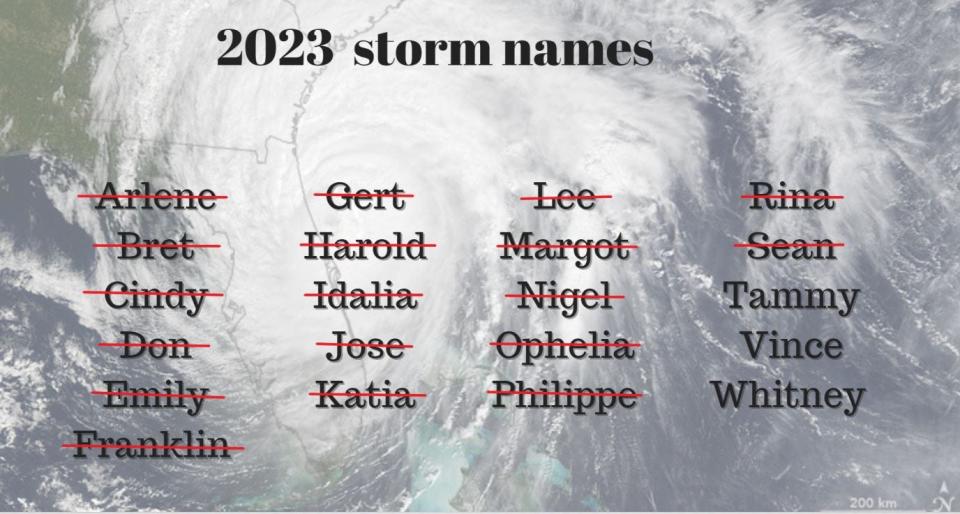The 2023 Hurricane season is not over yet with Florida vulnerable to storms into November
Tropical Storm Sean sputtered to life early Wednesday in a watery no-man’s-land and on a harmless path into the Atlantic abyss.
But the storm, which is expected to quickly fizzle, leaves just three names remaining on the traditional hurricane list with about seven weeks until season’s end.
If Tammy, Vince and Whitney are christened, it would be only the fourth time on record that a season has exhausted the names list and could mark the first time a supplemental list created in 2021 is used.
Already, 2023 is an unusually fecund year for tropical cyclones, with seven more named storms than normal through Oct. 11.

And with a brewing disturbance on Sean’s tail, Tammy could be born soon. The National Hurricane Center gave an area of low pressure south-southeast of the Cabo Verde Islands a 70% chance of development over seven days.
“The season’s not over, obviously,” said Phil Klotzbach, a hurricane researcher at Colorado State University. “We have two to three more weeks for some potentially nasty stuff.”
Klotzbach, who is the lead author of CSU’s hurricane season forecast, said he expects above-normal tropical activity at least through October.
Too many storms, not enough names: Greek alphabet banned after names confused people
Why hurricanes form close to home in October and November
Typically, this time of year is when the tropical waves — the seeds for the long-lived Cabo Verde hurricanes ― off Africa begin to lose steam over the main runway into the Caribbean.
Instead, storms find room to grow in the Gulf of Mexico and the Caribbean, often along fronts pushed into the lower latitudes by a winterizing jet stream.
But this year, meteorologists say October is looking more like August. Klotzbach quoted a friend from the National Hurricane Center as calling this month “Augtober” because of the waves still swirling off the African coast.
“I kind of just want to get through October,” said hurricane and storm surge expert Michael Lowry, a meteorologist with South Florida ABC affiliate Channel 10. “The fact that we are still looking at Africa is unusual. Three more storms would not surprise me.”
Florida's location makes it a target for late-season storms from the Gulf of Mexico and the Caribbean
Florida is especially vulnerable to storms in October. Since 1851, 37 October hurricanes have made a Florida landfall. Most of Florida's October storms have no name, forming before tropical cyclones were given monikers. But people still remember Irene, which scratched through Palm Beach County as a Category 1 in 1999, and 1998's Key West visit by Cat 2 Georges, and Cat 3 Opal's Pensacola landfall in 1995, and Floyd's 1987 spin through the Florida Keys.
Then there’s the unforgettable Hurricane Wilma in 2005, 2018’s Category 5 Michael and 1950’s King, which came ashore south of Miami as a Category 4.
“November storms are uncommon, but they happen, and when they happen, they tend to go to Florida,” Lowry said.
Go away: Could Hurricane Idalia make a second run at Florida after battering its west coast?
In recent years, hurricanes Eta and Iota formed in November 2020. Eta made landfall in the Florida Keys as a tropical storm on Nov. 9.
In 2022, hurricanes Martin and Nicole formed in November. Nicole made landfall near Vero Beach on Nov. 10 as a Category 1 storm.
"There's plenty of fuel left in the western Caribbean and Gulf," said Brian McNoldy, senior research associate for the University of Miami Rosenstiel School for Marine, Atmospheric and Earth Science. "If I had to guess, we probably do have a handful of storms left in the season."
People got confused when the Greek alphabet was used for storm names
It was 2020’s jaw-dropping 30 named storms that prompted the World Meteorological Organization to change the way tropical cyclones are named.
There are six rotating lists of traditional storm names. All end with the letter W and exclude Q, U, X, Y and Z because there are fewer names that start with those letters. (This year includes an unusual January storm that was unnamed but is included in the named storm list. That’s why Sean is the 19th named storm, even though it’s only the 18th letter used.)
The Greek alphabet was traditionally the backup list. It was used in 2020 and in 2005. In 2021, the names list was exhausted, but no storms formed after the late-season Wanda.
Meteorologists said people were confused by the naming conventions in the Greek alphabet that don’t follow the A, B, C, format and by names that sounded alike, such as Zeta, Eta and Theta. Also, the alphabet wasn’t translating well into Spanish, said former National Hurricane Center Ken Graham in 2021.
The new, and yet unused, supplemental names list starts with Adria, Braylen and Caridad.
“We are at 'S,' so we need three more named storms,” Klotzbach said. “Getting to the supplemental names list with a fourth storm after today would be a lot, but certainly not unheard of.”
Kimberly Miller is a veteran journalist for The Palm Beach Post, part of the USA Today Network of Florida. She covers real estate and how growth affects South Florida's environment. Subscribe to The Dirt for a weekly real estate roundup. If you have news tips, please send them to kmiller@pbpost.com. Help support our local journalism, subscribe today.
This article originally appeared on Palm Beach Post: 2023 hurricane season has nearly used up names list, with weeks to go

